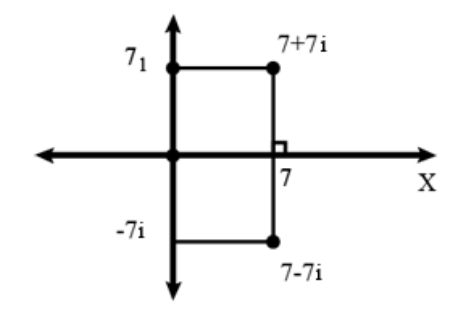
Answer
472.8k+ views
Hint: Here, we will first draw the diagram and then by symmetry of the points with respect to the \[x\]-axis, we can say \[x\]–axis is the perpendicular bisector of the line segment joining \[7 + 7i\] and \[7 - 7i\] to find the required equation.
Complete step-by-step answer:
We are given that the perpendicular bisector of the line segment joining the points \[7 + 7i\] and \[7 - 7i\] in the Argand diagram has the equation.

We know that the real part of the complex number has the \[x\]–value and the imaginary part of the complex number has the \[y\]–value.
Since we know that by symmetry of the points with respect to the \[x\]-axis, we can say \[x\]–axis is the perpendicular bisector of the line segment joining \[7 + 7i\] and \[7 - 7i\].
Thus, the required equation is \[y = 0\].
Hence, option A is correct.
Note: In solving these types of questions, students must know about the real and imaginary parts of a complex number. One should know the symmetry of the points with the axis to find the equation, which is the perpendicular bisector of the line segment.
Complete step-by-step answer:
We are given that the perpendicular bisector of the line segment joining the points \[7 + 7i\] and \[7 - 7i\] in the Argand diagram has the equation.

We know that the real part of the complex number has the \[x\]–value and the imaginary part of the complex number has the \[y\]–value.
Since we know that by symmetry of the points with respect to the \[x\]-axis, we can say \[x\]–axis is the perpendicular bisector of the line segment joining \[7 + 7i\] and \[7 - 7i\].
Thus, the required equation is \[y = 0\].
Hence, option A is correct.
Note: In solving these types of questions, students must know about the real and imaginary parts of a complex number. One should know the symmetry of the points with the axis to find the equation, which is the perpendicular bisector of the line segment.
Recently Updated Pages
Fill in the blanks with suitable prepositions Break class 10 english CBSE

Fill in the blanks with suitable articles Tribune is class 10 english CBSE

Rearrange the following words and phrases to form a class 10 english CBSE

Select the opposite of the given word Permit aGive class 10 english CBSE

Fill in the blank with the most appropriate option class 10 english CBSE

Some places have oneline notices Which option is a class 10 english CBSE

Trending doubts
Fill the blanks with the suitable prepositions 1 The class 9 english CBSE

How do you graph the function fx 4x class 9 maths CBSE

Which are the Top 10 Largest Countries of the World?

What is the definite integral of zero a constant b class 12 maths CBSE

The Equation xxx + 2 is Satisfied when x is Equal to Class 10 Maths

Differentiate between homogeneous and heterogeneous class 12 chemistry CBSE

Define the term system surroundings open system closed class 11 chemistry CBSE

Full Form of IASDMIPSIFSIRSPOLICE class 7 social science CBSE

Change the following sentences into negative and interrogative class 10 english CBSE




